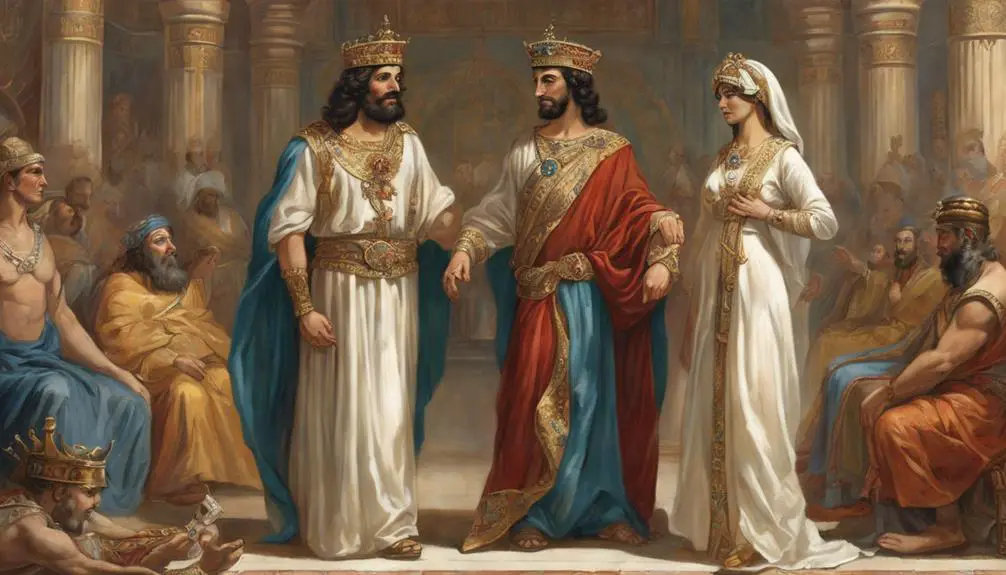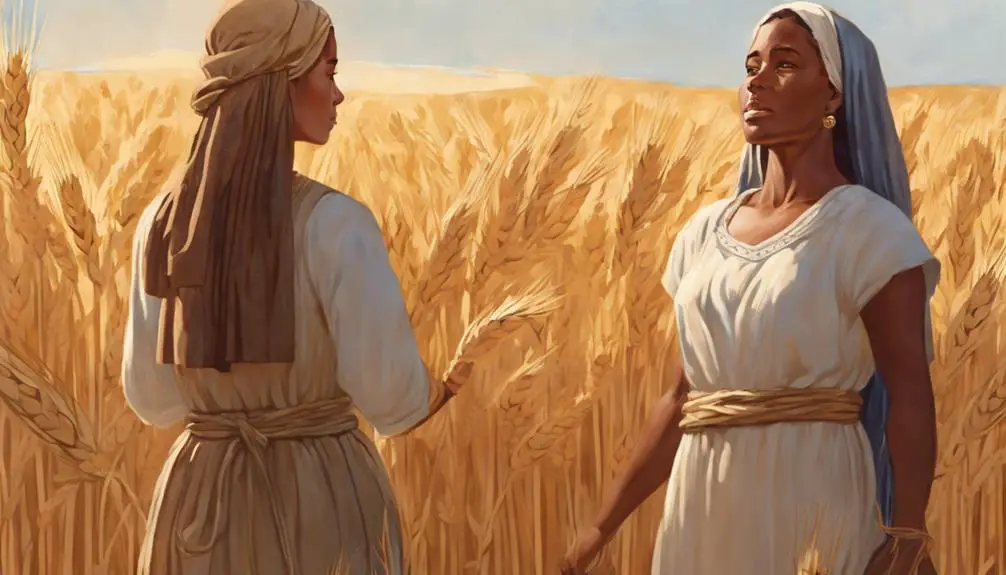Witness the enduring tales of Esther and Ruth in the Bible, where courage and loyalty forge legacies that echo through time.

Esther and Ruth in the Bible
Interestingly, among the 66 books of the Bible, only two are named after women: Esther and Ruth. You'll find that these narratives stand out not just for this reason but for the profound lessons they offer.
Esther's story showcases unparalleled courage in the face of annihilation, while Ruth's narrative redefines loyalty and love. As you explore these stories, you'll uncover timeless wisdom on how courage and loyalty can shape destinies.
What might these ancient texts reveal about the power of individual actions in the broader tapestry of history? Let's consider the impact these women's choices have had across generations.
Key Takeaways
- Esther and Ruth exemplify unparalleled courage and loyalty, impacting their communities and altering history.
- Both women challenged societal norms, showing the power of individual actions in achieving monumental outcomes.
- Their stories highlight the importance of faith, resilience, and the willingness to make personal sacrifices for the greater good.
- Esther's and Ruth's narratives offer timeless wisdom on identity, belonging, and the complexities of divine intervention.
The Story of Esther

The story of Esther, a narrative woven with themes of courage, identity, and divine providence, showcases how one woman's bravery can alter the course of history. Set against a backdrop of Persian intrigue, this tale unfolds in the court of King Xerxes, where Esther, an orphaned Jewish girl, rises to become queen due to her striking royal beauty and intelligence. Her ascent to power isn't merely a result of her physical appearance; it's a pivotal moment that sets the stage for her future acts of courage.
Esther's unique position in the Persian court provides an intriguing lens through which to examine the complexities of identity and power dynamics. Her story is a testament to the influence an individual can exert from within a system that's seemingly stacked against them. The interplay of Persian intrigue and Esther's royal beauty serves as a catalyst for the unfolding events, highlighting the unpredictable nature of power and the role of divine providence in guiding the outcomes of human affairs. Through Esther's narrative, you're invited to explore the profound impact of individual agency within the broader context of historical and divine currents.
Esther's Courageous Act

Esther's courageous act, in which she risked her life to save her people from annihilation, stands as a pivotal moment in the narrative, illustrating the profound impact of personal bravery on collective destiny. By approaching the king unsummoned, she not only defied the established norms of the royal court but also placed her own life in grave peril. This decision wasn't made lightly; it was a calculated act of faith and determination, underscored by her willingness to say, 'If I perish, I perish.'
Her intervention showcases the power of royal intervention when motivated by personal risk for a greater cause. The narrative emphasizes that Esther's actions weren't merely for personal gain but were driven by a deep sense of responsibility towards her people. Her bravery catalyzed a series of events that ultimately led to the salvation of the Jewish people in Persia.
The story of Esther serves as a testament to the idea that one person's courage can indeed alter the course of history. It underlines the significance of individual action within the broader context of divine providence and communal survival. Through Esther's example, the narrative conveys that personal risk, when taken for the welfare of others, can lead to monumental outcomes, especially when it involves royal intervention.
The Story of Ruth

In contrast to Esther's narrative, Ruth's story unfolds with a deep exploration of loyalty, devotion, and the unforeseen paths of redemption within the tapestry of human relationships. Ruth's journey from Moabite widow to a revered figure in Bethlehem encapsulates themes of resilience and divine providence. Central to her story are the actions taken during the harvest season and the pivotal role of Boaz's kindness.
To understand the significance of Ruth's narrative, consider these points:
- Ruth's Decision: Ruth chooses to leave her homeland and accompany Naomi, her mother-in-law, to Bethlehem, demonstrating profound loyalty.
- Harvest Season: Upon their arrival in Bethlehem, Ruth's initiative to glean in the fields during the harvest season signifies her determination to provide for Naomi and herself.
- Boaz's Kindness: Encounters with Boaz, a relative of Naomi's deceased husband, highlight the societal obligations of care and protection within ancient Israelite culture. Boaz's generosity extends beyond the mandated gleaning rights, reflecting a personal and communal ethic of kindness.
- Divine Providence: The narrative subtly weaves the theme of divine providence, suggesting that the seemingly mundane actions of individuals are part of a larger, divinely orchestrated plan.
Ruth's story, then, isn't just one of personal loyalty but also illustrates the broader communal responsibilities and the intricate ways in which human actions intersect with divine intentions.
Ruth's Loyalty Unveiled

Ruth's unwavering loyalty to Naomi, even in the face of personal loss and uncertainty, sets a profound example of steadfast devotion and selflessness. This narrative, deeply embedded within the cultural context of its time, showcases how familial ties extended beyond the biological into the realm of chosen relationships. Ruth's decision to stay with Naomi, articulated in the potent words, 'Where you go I'll go, and where you stay I'll stay,' transcends the expected family dynamics of the ancient Near East.
The cultural context of Ruth's era dictated that her primary allegiance would lie with her husband's family, yet, her husband's death typically would have severed this tie. However, Ruth's choice to cling to Naomi not only defies these expectations but also redefines the boundaries of loyalty and kinship. Her actions illuminate the power of unwavering commitment, suggesting a profound moral and ethical undertone to her loyalty that challenges the societal norms of her time.
Analyzing Ruth's loyalty within the framework of family dynamics uncovers a rich layer of complexity. It reveals a narrative where personal choice and devotion can indeed redefine traditional roles and relationships, offering a timeless exemplar of fidelity and love that transcends cultural and historical boundaries.
Lessons From Esther and Ruth

Reflecting on Ruth's profound loyalty, it's equally important to explore the moral and ethical teachings embedded in the narratives of both Esther and Ruth, highlighting their relevance to contemporary discussions on courage, faith, and identity. These stories not only provide historical insights but also offer valuable lessons that resonate with modern audiences. Here are four key teachings from their journeys:
- Courage in the Face of Adversity: Both women demonstrate remarkable courage—Ruth in her decision to leave her homeland and Esther in her bold approach to the king, risking her life for her people. Their actions teach us about the power of bravery and self-sacrifice.
- The Role of Divine Intervention: Their stories underscore the belief in divine intervention, where faith leads to unexpected outcomes. This highlights the importance of trust and patience in navigating life's challenges.
- Women's Leadership: Esther and Ruth are prime examples of women's leadership, showing how individuals can influence and change their communities through wisdom, dialogue, and action.
- Identity and Belonging: Through Ruth's integration into a new community and Esther's navigation of her dual identity, we learn about the complexities of identity and the journey toward finding one's place and voice within society.
Frequently Asked Questions
How Do the Themes of Esther and Ruth's Stories Intersect With Modern Feminist Interpretations?
You'll find that modern feminist interpretations often highlight how themes intersect with contemporary issues of gender roles and identity politics.
These narratives, when examined, reveal a rich tapestry of women navigating through societal constructs, challenging traditional roles, and asserting their agency.
This analysis doesn't just provide historical insight but also frames these stories as relevant discussions on empowerment, resilience, and the redefinition of femininity within a modern context.
In What Ways Have Esther and Ruth Been Represented in Art and Literature Outside the Bible?
You'll find Esther and Ruth depicted in various forms of art and literature beyond biblical texts, including operatic adaptations that bring their stories to life through music and performance. These adaptations often highlight the strength and agency of these figures, aligning with modern interpretations.
Additionally, culinary symbolism plays a significant role in their portrayal, reflecting the richness of their narratives and the cultural contexts in which they've been embraced and reimagined.
Can the Roles of Esther and Ruth Be Considered as Early Examples of Female Leadership and Empowerment in Religious Texts?
You're examining if certain roles can be seen as early instances of female leadership and empowerment in religious texts. These figures demonstrate unique leadership styles and empowerment methods, challenging traditional narratives.
Their stories offer insights into how women navigate and influence their environments, embodying leadership qualities and empowering actions.
This analysis helps understand the evolution of female representation in religious contexts, highlighting their significance in shaping leadership and empowerment paradigms.
How Do Different Religious Traditions Interpret the Characters and Stories of Esther and Ruth Differently?
Different religious traditions interpret these characters and their stories through various lenses.
You'll find that feast symbolism and divine intervention are pivotal in understanding their roles across cultures.
For instance, Esther's narrative is celebrated in Judaism during Purim, emphasizing her bravery and divine intervention.
Meanwhile, Christianity often highlights Ruth's loyalty and faith as exemplary, interpreting divine intervention in her story as God's providence.
Each tradition offers a unique perspective on leadership and faith.
What Are the Historical and Cultural Contexts of the Time Periods in Which Esther and Ruth Lived, and How Do These Contexts Influence Our Understanding of Their Stories?
Understanding the historical and cultural contexts of any time period, including agricultural practices and social hierarchies, is crucial. It shapes your grasp of narratives and characters within that era.
When you delve into these contexts, you'll see how they influence stories, revealing deeper meanings and motivations. For Esther and Ruth, these elements highlight their resilience and the revolutionary nature of their actions within their respective societal structures and times.
Conclusion
In analyzing the narratives of Esther and Ruth, you'll find both stories underscore the profound themes of courage and loyalty within adverse circumstances. Esther's audacious act of bravery and Ruth's unwavering loyalty serve as pivotal examples of steadfast faith and resilience.
These narratives not only highlight the significant roles women played in biblical history but also offer timeless lessons on the virtues of bravery and fidelity. Thus, Esther and Ruth's stories remain relevant, inspiring individuals to embody such qualities in their lives.



Sign up